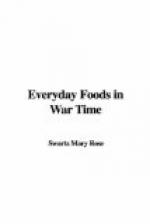No diet can be properly built without a suitable supply of mineral salts. The free use of milk is our greatest safeguard against lack of any save iron, but when milk is scarce and has to be saved as now for the babies of the world, it is fortunate that we can make fruits and vegetables take its place in part. Some of our very common vegetables are good sources of the calcium (lime) and phosphorus so freely supplied in milk. Among these may be taken as an example the carrot, which has not had due recognition in many quarters and in some is even spoken of contemptuously as “cattle food.” Its cheapness comes from the fact that it is easy to grow and easy to keep through the winter and should not blind us to its merits. A good-sized carrot (weight one-fourth pound) will have only about half the fuel value of a medium-sized potato, but nearly ten times as much calcium as the potato and about one-third more phosphorus. While actual figures show that other vegetables, especially parsnips, turnips, celery, cauliflower, and lettuce, are richer in calcium than the carrot, its cheapness and fuel value make it worthy of emphasis. Everyone who has a garden should devote some space to this pretty and palatable vegetable. It is perhaps at its best when steamed till soft without salting and then cut up into a nicely seasoned white sauce; its sweetness will not then be destroyed nor its salts lost in the cooking water. It is not only useful as a hot vegetable, but in salads, in the form of a toothsome marmalade, and as the foundation of a steamed pudding. For little children it is most wholesome and they should make its acquaintance by the time they are a year and a half old, in the form of a cream soup. A dish of carrots and peas (one-half cup peas, one-fourth cup carrot cubes, one-half cup white sauce) will have almost the same food values (for fuel, calcium, phosphorus, and iron) as an equivalent serving of oatmeal, milk, and sugar (three-fourths cup cooked oatmeal, one-half cup milk, one rounding teaspoon sugar) and will add variety to the diet without costing a great deal more unless one pays a fancy price for peas.
Even when meat and eggs are not prohibitive in price, fruit and green vegetables are an important source of iron in the diet. And when war conditions make the free consumption of meat unpatriotic, it is reassuring to think that we really can get along without meat very well if we know how. Two ounces of lean beef will furnish no more iron than a quarter of a cup of cooked spinach or half a cup of cooked string beans or dried beans, or one-sixth of a cup of raisins, or half a dozen good-sized prunes. Cabbage, peas, lettuce, dandelion greens, beet tops, turnip tops and other “greens” are well worth including in our bill of fare for their iron alone. By the time children are a year old we begin to introduce special iron-bearing foods into their diet to supplement milk. Aside from egg yolk, we give preference for this purpose to green




